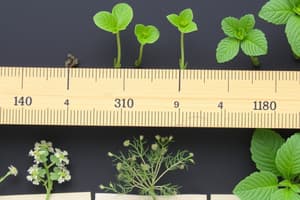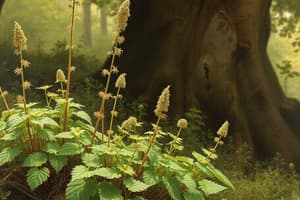Podcast
Questions and Answers
Which of the following statements describes nonvascular plants?
Which of the following statements describes nonvascular plants?
- Grow tall and large
- Have a system of tubelike structures
- Absorb moisture and nutrients through their leaves (correct)
- Have true roots
What are examples of moss?
What are examples of moss?
Moss, liverwort, hornwort
What beneficial role do mosses play in the environment?
What beneficial role do mosses play in the environment?
They help prevent erosion and are often among the first plants to grow in disturbed areas.
What is liverwort?
What is liverwort?
Which plant typically has chloroplasts that can store carbon dioxide?
Which plant typically has chloroplasts that can store carbon dioxide?
What is a characteristic of vascular plants?
What is a characteristic of vascular plants?
What defines seedless vascular plants?
What defines seedless vascular plants?
Which of the following describes horsetails?
Which of the following describes horsetails?
What is a defining feature of club moss?
What is a defining feature of club moss?
What are the reproductive structures of ferns called?
What are the reproductive structures of ferns called?
Which group of plants produces seeds?
Which group of plants produces seeds?
What is a spore?
What is a spore?
What are gymnosperms?
What are gymnosperms?
What distinguishes ginkgoes?
What distinguishes ginkgoes?
Where are gnetophytes typically found?
Where are gnetophytes typically found?
What are conifers?
What are conifers?
What characterizes angiosperms?
What characterizes angiosperms?
Define an annual plant.
Define an annual plant.
What is a biennial plant?
What is a biennial plant?
What defines a perennial plant?
What defines a perennial plant?
What are monocotyledons?
What are monocotyledons?
What are dicotyledons?
What are dicotyledons?
Flashcards are hidden until you start studying
Study Notes
Nonvascular Plants
- Absorb moisture and nutrients through leaves, often found in moist environments.
- Do not grow large or have true roots; instead, use rhizoids at the base.
- Examples include moss, liverwort, and hornwort.
Moss
- Typically spread in groups and cover vast areas.
- They are pioneer plants, aiding in soil stabilization after disturbances like fires or volcanic eruptions.
- Peat moss has applications in heating, cooking, gardening, and medicine.
Liverwort
- Features leaf-like structures on stems, some flattened resembling a liver.
- Contains numerous chloroplasts and cannot store carbon dioxide.
- Spore capsules release spores rapidly, usually within hours.
Hornwort
- Chloroplasts are large and can store carbon dioxide, essential for photosynthesis.
- Lacks oil bodies typically found in other plant cells.
- Capable of continuous spore production, often found in aquatic habitats.
Vascular Plants
- Possess a system of tubelike structures for water and nutrient transport.
- This vascular system supports and strengthens the plant’s structure.
Seedless Vascular Plants
- Reproduce via rhizomes and spores rather than seeds, primarily in moist areas.
- Examples include horsetails, clubmoss, and ferns.
Horsetails
- Characterized by tall, hollow stems with jointed sections.
- Needle-like branches may grow at joints, and small scale-like leaves often hug the stem.
- Thrive in wet environments such as riverbanks and marshes.
Club Moss
- Generally do not exceed 30 cm in height and resemble miniature evergreen trees.
- Known for growing in mixed forest settings.
Ferns
- Display fronds; young fronds are called fiddleheads.
- Produce spores in casings located on the underside of leaves.
Seed Bearing Vascular Plants
- Reproduce with seeds, differentiated into gymnosperms and angiosperms based on seed production methods.
Seed
- Defines a plant embryo with nutritional reserves located in the cotyledon.
Spore
- A microscopic reproductive particle released by plants, fungi, or algae that can germinate into a new organism.
Gymnosperms
- Produce seeds within cones; key examples include cycads, ginkgoes, gnetophytes, and conifers.
Ginkgoes
- Feature round cones and fan-shaped leaves that yellow in autumn; they are deciduous.
Gnetophytes
- Adaptable to hot, dry areas or tropical rainforests; can be trees, shrubs, or vines.
- Some have cone-like structures that resemble flowers.
Conifers
- Majority are evergreen with needle-like or scalelike leaves; live longer in colder climates.
- Include both tall trees and woody shrubs.
Angiosperms
- Vascular plants that produce flowers and fruit, crucial for food and medicine.
- Classified into monocots and dicots based on seed structure.
Annual
- Angiosperms that complete their life cycle within one growing season (e.g., marigolds, tomatoes).
Biennial
- Angiosperms that require two growing seasons to mature (e.g., parsley, carrots).
Perennial
- Angiosperms that live for three or more years, includes trees, shrubs, and smaller plants like spearmint.
Monocotyledons (Monocots)
- Have one cotyledon; exhibit non-arranged tubelike structures.
- Characterized by long, narrow leaves with parallel veins, includes grain species.
Dicotyledons (Dicots)
- Feature two cotyledons; tubelike structures arranged in a ring for thicker growth.
- Broad, flat leaves with a net of veins, include many common plants like roses and beans.
Studying That Suits You
Use AI to generate personalized quizzes and flashcards to suit your learning preferences.




